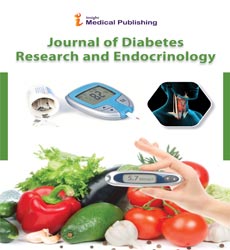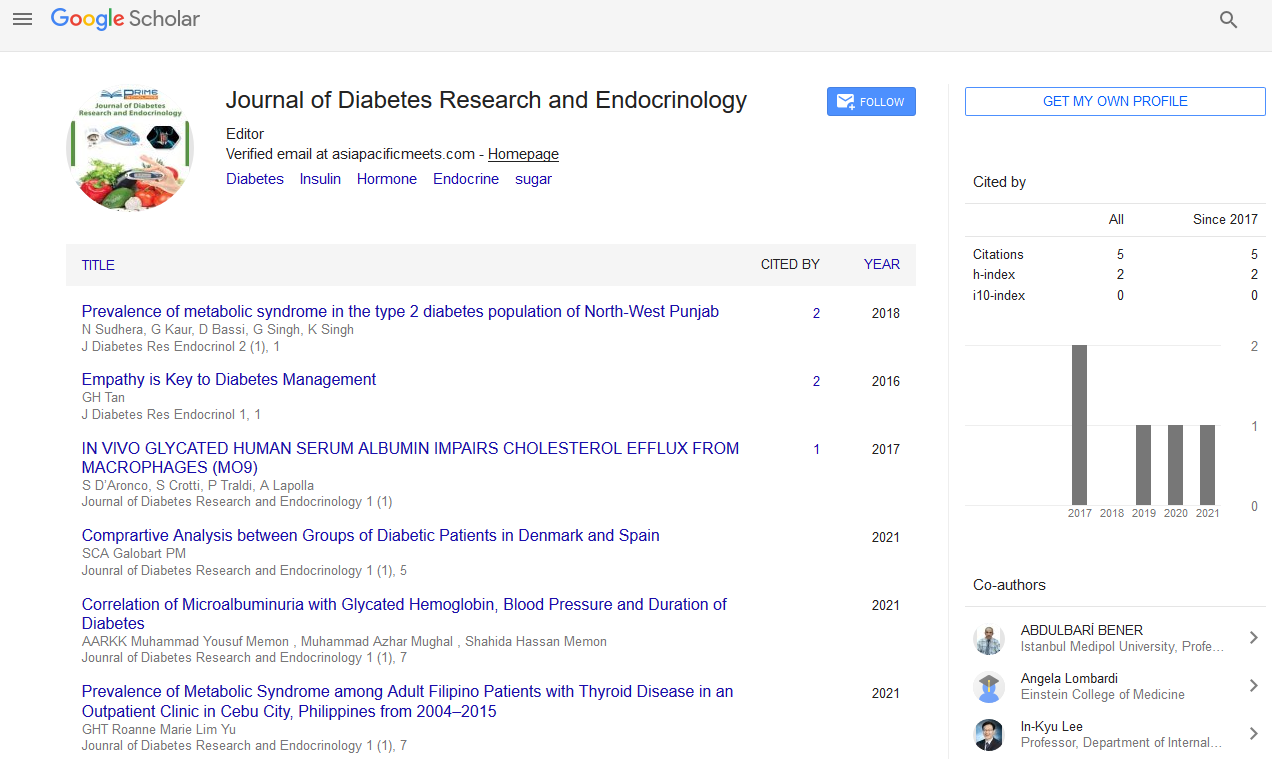Keywords
Diabetes mellitus type 2; Hemoglobin A; Risk factors
Introduction
Diabetes has turned into one of the most serious health problems of our time, with increasing figures about mortality and morbidity. The continuous rising in diabetes figures has led us to implement preventive measures, early-detection and life and treatment changes with the aim of preventing the disease or postpone its complications [1].
The International Diabetes Federation (IDF) publishes the prevalence of Diabetes periodically [2]. This prevalence depends on the values that are used for its diagnosis, whether they are taken from the plasma glucose levels, from the oral glucose overload or from the glycated haemoglobin [3,4].
From 1980, prevalence is growing regardless of the country. This fact is linked to the ageing of the population and to the increase of the body mass index [5,6]. This prevalence rising has been higher in low and middle income populations [7,8]. In 2014, prevalence at a global level was 422 million of adults. There are not any available estimates about separated prevalence in type 1 diabetes and type 2 diabetes. Most people affected have type 2 diabetes, which used to be exclusive of adults, but which is also being described now in children [9].
In Spain, diabetes prevalence is 9.4%, with men having a higher rate than women; while in Denmark prevalence is 6.1% and it is also higher in men [1].
In 2012, diabetes caused 1.5 million of deaths. The main complications were heart attack, ictus, blindness, kidney failure and lower extremity amputation [10-13].
As for the most relevant preventive measures, there should be noted those applicable to all types of population: healthy life habits, daily exercise, balanced diet, avoid smoking and drinking alcohol and taking the periodic checks on lipids and blood pressure.
Furthermore, the later diabetes is diagnosed; the worst the consequences might be for your health. That is the reason why it is important to have access to test results and to consult doctors in case of complications. With reference to already diagnosed people, there is a series of cost-effective measures that can improve results, such as glycemic control combined with a balanced diet and exercise. Also, control of blood pressure and lipids, eye, kidney and foot checks all that must be done periodically [14-17].
Diabetes leads to considerable costs for the health system and for the patient who suffers it [18].
In Spain as in Denmark, diabetes represents 3% of the total number of deaths by any cause or age. In Spain, there are a higher percentage of people suffering from overweight, obesity and inactivity. With regards to the national strategy against diabetes, guidelines are similar in both countries, except for the registration of diabetes cases which was not carry out in Spain but in Denmark, according to WHO data.
Concerning resources, medicines availability, basic techniques and access to the health system, both countries take similar action by offering adequate health assistance to the population [1].
Objective
Main objective
The main objective was to compare the degree of control of two groups of diabetic patients; one from Denmark and the other one from Spain. This was done by analyzing glycated figures, BMI, LDL cholesterol and blood pressure.
Secondary objectives
The secondary objective consists of valuing the degree of statistical registration in both systems along with establishing hygienic- dietetic improvements regarding the degree of control in these patients according to the results.
Looking for possible explanations in regards to lifestyle and habits according to the results is also part of the objective.
Materials and Methods
It is a cross curricular study based on a sample of 99 diabetic people who had been chosen randomly from a data base in two health centres located in two different countries: one health centre in Spain (Seville) and the other one in Denmark (Holbaek). In this study, the variables in both health centres are compared: age, sex, figures of glycated haemoglobin, body mass index, LDL cholesterol and figures of systolic and diastolic blood pressure. The information was collected from data bases which were requested to the management department in each centre and which had been collected between April and September 2015. The statistical analysis had been realised with R, version 3.3.1. We considered significant values less or equal to 0.05. The comparative analysis of means had been expressed using mean± standard deviation with the application of Student t test for quantitive values and Chi square for qualitive values. Relative risk is determined for every risk factor with their own confidence interval.
Results
A total of 99 diabetic patients were analyzed, of which 49 belonged to a health center in the town, Seville (Spain) and 50 to a rural health center in Holbaek (Denmark) (Figure 1).

Figure 1: A total of 99 diabetic patients were analyzed, of which 49 belonged to a health center in the town, Seville (Spain) and 50 to a rural health center in Holbaek (Denmark).
Sex variable
In the sample of Seville, the percentage of men was 53% while that of women was 47%. In the sample in Holbaek, the percentage of men was 54% and that of women 46%. In the total sample, the percentage was 53.54% for men and 46.46% for women (Figure 2).

Figure 2: Sex variable.
Age variable
The average age in each sample was 67.06 years in Holbaek and 67.02 years in Seville.
An outlier was also noted in Seville, being this one 33 years old (Figure 3).

Figure 3: Age variable.
BMI
The BMI was similar in both places, being the BMI average 30.65 in Holbaek and 30.14 in Seville (Figure 4).

Figure 4: BMI.
LDL
LDL figures were the only values that really were different in both samples, being the average LDL 78.64 in Holbaek and 98.91 in Seville (Figure 5).

Figure 5: LDL.
HbA1c
Glycated hemoglobin values were similar in both samples, being the glycated average 6.8% in Holbaek and 6.6% in Seville. In this variable, we can note some outliers in both places (Figure 6).

Figure 6: HbA1c.
TAS
TAS average values were 125 mmHg in Holbaek and 129 mmHg in Seville. In this graphic, it is possible to see more outliers in Holbaek than in Seville (Figure 7).

Figure 7: TAS (Systolic blood pressure).
TAD
TAD average values were 81 mm Hg in Holbaek and 76 mm Hg in Seville (Figure 8).

Figure 8: TAD (Diastolic blood pressure).
Discussion
Even though samples were taken randomly, they were quite homogeneous in both cases, being the percentages for men and women similar. Average age of patients was 67 years old.
When comparing the BMI in both groups, there weren’t any significant differences statistically speaking; being the BMI average 30 kg/m2 in both places.
Significant differences were only found when analysing LDL figures. Average LDL in Holbaek was 78.64 mg/dL, while it was 98.91 mg/dL in Seville.
No other variable from the study presented any significant differences statistically speaking. There were similar values concerning glycated hemoglobin, being the average 6.8% in Holbaek and 6.6% in Seville. The average TAS was 125 mm Hg in Holbaek and 129 mm Hg in Seville. The average TAD values were 81 mm Hg in Holbaek and 77 mm Hg in Seville.
As for LDL cholesterol figures, differences could be explained by the differences in the lifestyles predominant in both cultures.
According to WHO, we count in Spain with higher rates of obesity, overweight and physical inactivity than in Denmark. There are studies which confirm the suitability of the Mediterranean diet in order to improve prevention and the management of diabetic patients [12,18]. If we observe these results, we could think that this typical diet in Spain is becoming obsolete. At the same time, the continuous use of the bike in Denmark as the way of transport could be another possible explanation for the fact mentioned above.
The current trend would consist of increasing obesity and physical inactivity rates even more [14].
Therefore, insistence about the importance of keeping a healthy diet along with practising exercise periodically should be one of the main objectives for these patients11; especially, in order to stop prevalence from rising in this disease [9].
It should be noted that there are not enough articles comparing differences in both countries on which to base this study.
References
Results are similar due to the fact that samples do not represent each of these countries but the whole diabetic population. This explains the resemblance of diabetic population regardless where it comes from, since this is a direct consequence of the same unhealthy lifestyle, including a poor diet and the lack of physical activity.
References
- Informe Mundial sobre la Diabetes (2016) OMS.
- International Diabetes Federation. IDF Diabetes Atlas, 6th edn. (2013) Brussels: International Diabetes Federation.
- Danaei G, Finucane MM, Lu Y, Singh GM, Cowan MJ, et al. (2011) National, regional, and global trends in fasting plasma glucose and diabetes prevalence since 1980: Systematic analysis of health examination surveys and epidemiological studies with 370 country-years and 2.7 million participants. Lancet 378: 31-40.
- NCD Risk Factor Collaboration (2015) Effects of diabetes definition on global surveillance of diabetes prevalence and diagnosis: A pooled analysis of 96 population-based studies with 331 288 participants. Lancet Diabetes Endocrinol 3: 624-637.
- (2016) Diabetes care, pp: 4-5.
- Worldwide Trends in Diabetes since 1980 (2016) A pooled analysis of 751 population-based studies with 4.4 million participants. Lancet 387: 1513-1530.
- Icks A, Moebus S, Feuersenger A, Haastert B, Jockel KH, et al. (2007) Diabetes prevalence and association with social status--Widening of a social gradient? German National Health Surveys 1990-1992 and 1998. Diabetes Res Clin Pract 78: 293-297.
- Guariguata L, Whiting DR, Hambleton I, Beagley J, Linnenkamp U, et al. (2014) Global estimates of diabetes prevalence for 2013 and projections for 2035. Diabetes Res Clin Pract 103: 137-149.
- Global Burden of Metabolic Risk Factors for Chronic Diseases Collaboration (2014) Cardiovascular disease, chronic kidney disease, and diabetes mortality burden of cardiometabolic risk factors from 1980 to 2010: A comparative risk assessment. Lancet Diabetes Endocrinol 2: 634–647.
- Ezzati M, Riboli E (2013) Behavioral and dietary risk factors for non-communicable diseases. N Engl J Med 369: 954-964.
- Ley SH, Hamdy O, Mohan V, Hu FB (2014) Prevention and management of type 2 diabetes: Dietary components and nutritional strategies. Lancet 383: 1999-2007.
- Saaristo T, Moilanen L, Korpi-Hyovalti E, Vanhala M, Saltevo J, et al. (2010) Lifestyle intervention for prevention of type 2 diabetes in primary health care: One-year follow-up of the Finnish National Diabetes Prevention Program (FIN-D2D). Diabetes Care 33: 2146-2151.
- Fox CS, Golden SH, Anderson C, Bray GA, Burke LE, et al. (2015) Update on prevention of cardiovascular disease in adults with type 2 diabetes mellitus in light of recent evidence: A scientific statement from the American Heart Association and the American Diabetes Association. Circulation 132: 691-718.
- Skyler JS, Bergenstal R, Bonow RO et al. (2009) Intensive glycemic control and the prevention of cardiovascular events: Implications of the ACCORD, ADVANCE and VA diabetes trials: A position statement of the American Diabetes Association and a scientific statement of the American College of Cardiology Foundation and the American Heart Association. Circulation 119: 351-357.
- NCD Risk Factor Collaboration (NCD-RisC) (2016) Trends in adult body-mass index in 200 countries from 1975 to 2014: A pooled analysis of 1698 population-based measurement studies with 19.2 million participants. Lancet 387: 1377-1396.
- Pedro-Botet J, Benaiges D, Pedragosa A (2012) Diabetic dyslipidemia, macro and macroangiopathy. Clin Invest Arterioscl 24: 299-305.
- Seuring T, Archangelidi O, Suhrcke M (2015) The economic costs of type 2 diabetes: A global systematic review. Pharmacoeconomics 33: 811-831.
- Salas-Salvadó J, Guasch-Ferré M, Lee CH, Estruch R, Clish CB, et al. (2016) Protective effects of the mediterranean diet on type 2 diabetes and metabolic syndrome. J Nutr 57: 1299-1313.









